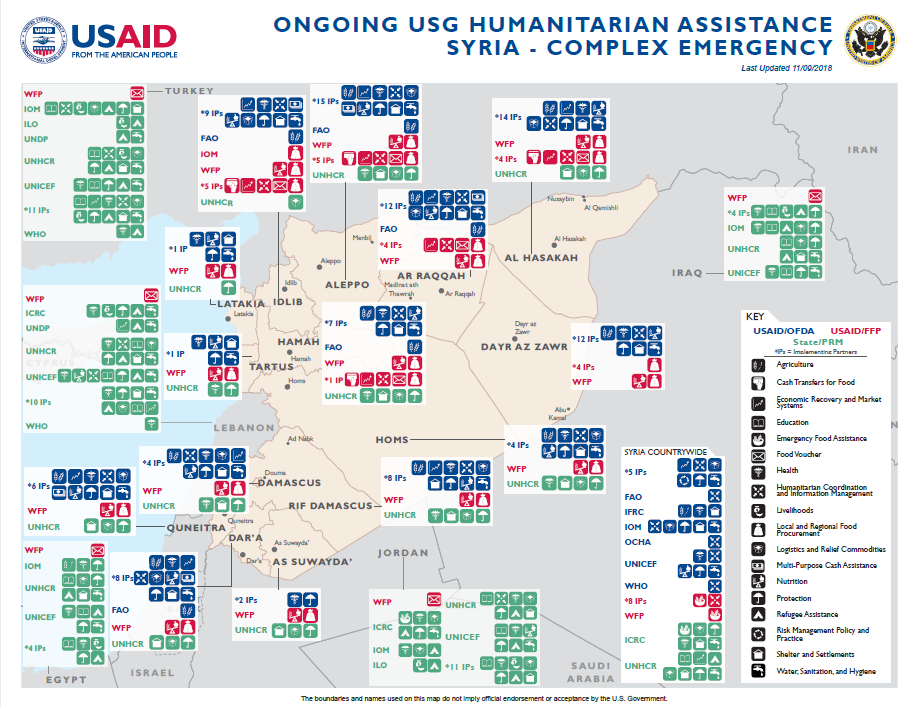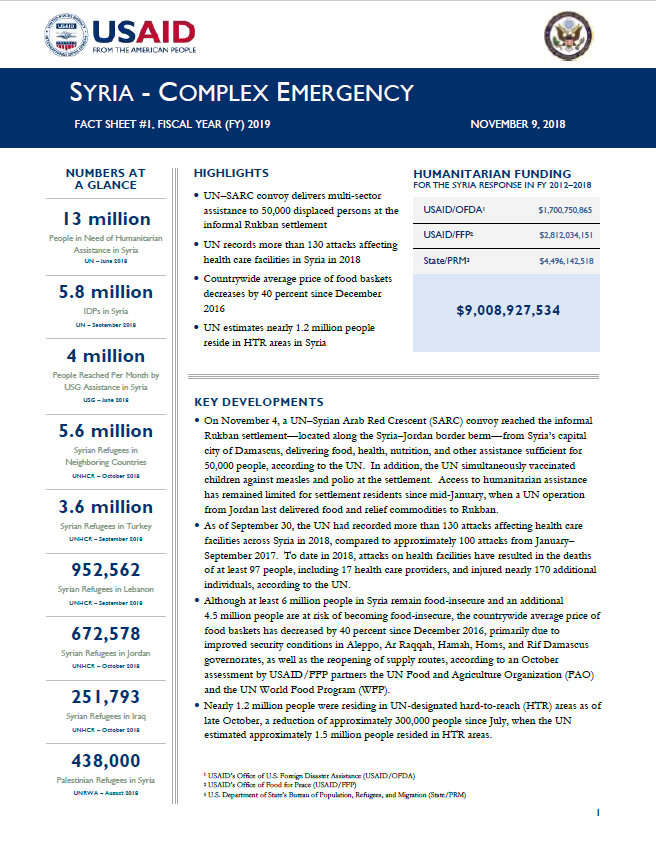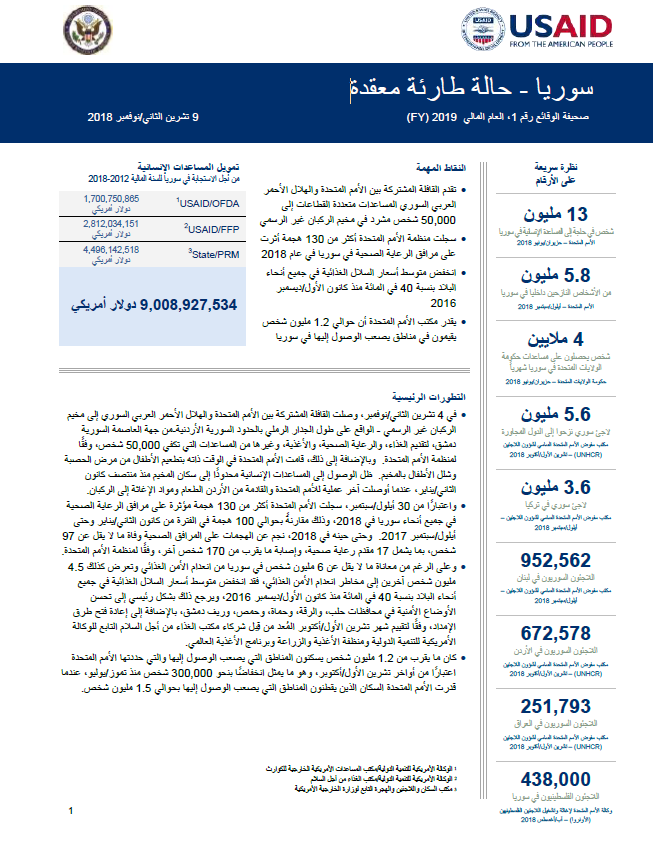- What We Do
- Agriculture and Food Security
- Democracy, Human Rights and Governance
- Economic Growth and Trade
- Education
- Environment and Global Climate Change
- Gender Equality and Women's Empowerment
- Global Health
- Humanitarian Assistance
- Transformation at USAID
- Water and Sanitation
- Working in Crises and Conflict
- U.S. Global Development Lab
Speeches Shim
November 09, 2018
Highlights
UN–SARC convoy delivers multi-sector assistance to 50,000 displaced persons at the informal Rukban settlement
UN records more than 130 attacks affecting health care facilities in Syria in 2018
Countrywide average price of food baskets decreases by 40 percent since December 2016
UN estimates nearly 1.2 million people reside in HTR areas in Syria
Key Developments
On November 4, a UN–Syrian Arab Red Crescent (SARC) convoy reached the informal Rukban settlement—located along the Syria–Jordan border berm—from Syria’s capital city of Damascus, delivering food, health, nutrition, and other assistance sufficient for 50,000 people, according to the UN. In addition, the UN simultaneously vaccinated children against measles and polio at the settlement. Access to humanitarian assistance has remained limited for settlement residents since mid-January, when a UN operation from Jordan last delivered food and relief commodities to Rukban.
As of September 30, the UN had recorded more than 130 attacks affecting health care facilities across Syria in 2018, compared to approximately 100 attacks from January–September 2017. To date in 2018, attacks on health facilities have resulted in the deaths of at least 97 people, including 17 health care providers, and injured nearly 170 additional individuals, according to the UN.
Although at least 6 million people in Syria remain food-insecure and an additional 4.5 million people are at risk of becoming food-insecure, the countrywide average price of food baskets has decreased by 40 percent since December 2016, primarily due to improved security conditions in Aleppo, Ar Raqqah, Hamah, Homs, and Rif Damascus governorates, as well as the reopening of supply routes, according to an October assessment by USAID/FFP partners the UN Food and Agriculture Organization (FAO) and the UN World Food Program (WFP).
Nearly 1.2 million people were residing in UN-designated hard-to-reach (HTR) areas as of late October, a reduction of approximately 300,000 people since July, when the UN estimated approximately 1.5 million people resided in HTR areas.
Syria Complex Emergency - Map #1 FY19 ![]() (pdf - 468k)
(pdf - 468k)
Numbers At A Glance
13 million
5.8 million
4 million
5.6 million
3.6 million
952,562
672,578
251,793
438,000
Humanitarian Funding
To Syria Humanitarian Response
FY 2012 - FY 2018
| USAID/OFDA | $1,700,750,865 |
| USAID/FFP | $2,812,034,151 |
| State/PRM | $4,496,142,518 |
| TOTAL | $9,008,927,534 |
Syria Complex Emergency - Fact Sheet #1 FY19 ![]() (pdf - 306k)
(pdf - 306k)
Syria Complex Emergency - Fa ct Sheet #1 FY19 Arabic ![]() (pdf - 389k)
(pdf - 389k)
INSECURITY, DISPLACEMENT, AND HUMANITARIAN ACCESS
Conflict in Syria killed at least 167 civilians during October, including at least 42 deaths due to Syrian Arab Republic Government (SARG) and Government of the Russian Federation military operations, according to the Syria Network for Human Rights (SNHR). To date in 2018, SNHR has recorded at least 6,395 civilian deaths in Syria.
Nearly 1.2 million people were residing in HTR areas of Syria as of late October, representing a 26 percent decrease from the approximately 1.5 million people residing in HTR areas in July, the UN reports. Dayr az Zawr Governorate hosts Syria’s largest HTR population, approximately 298,000 people, followed by Homs and Rif Damascus, which host approximately 210,000 and 195,000 people in HTR areas, respectively. The reduction in HTR populations is largely due to SARG territorial gains and shifting lines of control, allowing areas to become newly accessible.
During a late October address to the UN Security Council (UNSC), UN Under-Secretary-General for Humanitarian Affairs and Emergency Relief Coordinator Mark Lowcock called for the renewal of the mandate of UNSC Resolution 2165, which authorizes UN cross-border humanitarian access to Syria and is set to expire on January 10, 2019. From January–September 2018, the UN provided assistance to an estimated 750,000 people per month through cross-border operations. In addition, the UN has relied on cross-border operations from Turkey to pre-position relief commodities, including plastic sheeting and winterization items, in anticipation of a potential SARG military offensive in Idlib and Hamah governorates.
Northeastern Syria
Escalated conflict between Islamic State of Iraq and Syria (ISIS) militants and Syrian Democratic Forces in southern Dayr az Zawr displaced approximately 30,000 people from June–October, according to the UN. On October 16, the UN released a statement calling on all parties to the conflict to protect civilians and improve access to areas near Dayr az Zawr’s Hajin town. The UN also called on all parties to enable freedom of movement for civilians and the relocation of informal settlements farther from frontlines of conflict. As of late September, approximately 15,000 people remained in ISIS-controlled areas in the governorate’s Hajin sub-district, relief organizations report.
Displaced populations continue to return to areas of origin in Ar Raqqah city and require assistance meeting basic needs. As of October, approximately 50 percent of Ar Raqqah households reported being unable to meet basic needs, such as food and winterization items, according to a REACH Initiative survey. Additionally, city residents continue to experience difficulties accessing health care services due to lack of sufficient medical personnel and medical supplies, and many households continue to rely on generators for electricity due to significant damage to Ar Raqqah’s electrical infrastructure. Although some Ar Raqqah residents can access safe drinking water through the city’s main water network, residents in outlying neighborhoods face challenges accessing water and are relying on negative coping mechanisms, such as consuming previously-stored water and modifying hygiene practices to conserve water.
From August–September, the median cost of fuel in northeastern Syria increased by nearly 50 percent in anticipation of winter weather-related heating needs, according to REACH. In addition, increased fuel costs have contributed to a nearly 40 percent increase in water trucking costs in northeastern Syria since August.
Northwestern Syria
More than 3.9 million people were residing in northwestern Syria as of September, including an estimated 1.9 million internally displaced persons (IDPs), according to State/PRM partner the Office of the UN High Commissioner for Refugees (UNHCR). While the majority of IDPs across northwestern Syria are sheltering with host communities, approximately 418,000 people, including an estimated 300,000 IDPs in Idlib, were residing in more than 330 camps, informal settlements, and transit centers as of September. Relief organizations, including USAID partners, reached approximately 268,000 IDPs in Idlib—nearly 90 percent of the governorate’s IDP population—with multi-sector assistance in August and continued to provide regular, life-saving assistance as of early November, the UN reports.
From January–September, UNHCR distributed relief commodities and shelter materials to nearly 219,000 people, including more than 155,000 people displaced from Aleppo’s Afrin District to Aleppo’s Tell Refaat sub-district and Fafin, Nabul, and Zahraa towns. UNHCR also provided protection services, including legal services and assistance obtaining documentation, to more than 117,000 people in northwestern Syria during the same period.
Southern Syria
From November 4 to 6, a UN–SARC convoy delivered multi-sector assistance—including food, health, and nutrition supplies, as well as hygiene kits, plastic sheeting, and winter clothes—sufficient to support 50,000 people at the informal Rukban settlement, according to the UN. The UN also vaccinated children against measles and polio. The convoy represented the first time that assistance had been delivered to the settlement from Damascus. Access to humanitarian assistance has remained limited for Rukban residents since mid-January, when a UN operation from Jordan delivered food and relief commodities. Conditions in the settlement remain poor, with insufficient food and medicines resulting in at least 12 deaths in recent weeks, international media report.
FOOD SECURITY AND NUTRITION
Following an extended dry period early in the planting season and late heavy rainfall, wheat production in Syria fell by approximately 30 percent in 2018 compared to 2017, representing a 29-year low, according to USAID/FFP partner FAO. Conflict, displacement, and a limited supply of agricultural inputs and equipment also negatively affected production.
Although food insecurity persists in Syria, the countrywide average food basket price has decreased by 40 percent since December 2016, largely due to security improvements in Aleppo, Ar Raqqah, Hamah, Homs, and Rif Damascus, as well as the reopening of supply routes, according to an October FAO–WFP food security assessment. In addition, WFP reports increased humanitarian access to populations residing in former HTR areas. Despite increased access to humanitarian assistance and markets in some areas, at least 6 million people in Syria remain food-insecure—including 500,000–800,000 people in Idlib—and an additional 4.5 million people are at risk of becoming food-insecure, according to WFP.
USAID/FFP partner WFP provided emergency food assistance to approximately 3 million people in all of Syria’s 14 governorates in September, including more than 407,000 people residing in approximately 60 HTR areas in Aleppo, Ar Raqqah, Dar’a, Dayr az Zawr, Hamah, Homs, and Rif Damascus governorates. In September, WFP distributed food rations sufficient for 12,500 IDPs and host community members in Hajin sub-district for one month. In addition, WFP livelihood activities—including food processing, farming support, and vocational training—benefited nearly 126,000 people across 11 governorates from January–September.
In September, WFP provided nutrition supplies for the prevention of acute malnutrition for nearly 122,000 children in Aleppo, Al Hasakah, Ar Raqqah, Damascus, Dar’a, Hamah, Homs, Quneitra, Rif Damascus, and Tartus governorates. In addition, WFP delivered nutrition supplies to health centers and mobile clinics in Damascus and Homs sufficient to treat nearly 920 children and pregnant and lactating women experiencing moderate acute malnutrition.
HEALTH
Approximately 12 million people across Syria required health assistance as of September, according to the Health Cluster. However, limited health facilities, medical personnel, supplies, and specialized health care services continue to restrict health care access for vulnerable populations in Syria. As of late September, approximately 51 percent of the 1,770 private health care centers in Syria were fully functional, while 64 percent of Syria’s estimated 200 public hospitals were operational, the UN reports.
Attacks against health care facilities and workers continue to hinder access to services across Syria. From January– September, the UN recorded more than 130 attacks—approximately 70 percent of which occurred in Idlib and Rif Damascus—impacting health care facilities across Syria. Attacks impacting health facilities resulted in the deaths of at least 97 people, including 17 health care providers, and injured an additional 170 people, according to the UN.
Health actors recorded more than 780 diarrhea cases, including 12 deaths, from March–September in Dayr az Zawr, primarily in Al Husseinieh District, according to the Health Cluster. Although disease surveillance data indicate that the outbreak has stabilized to an average of 10 cases per week, diarrhea remained the primary health concern among nearly 60 percent of surveyed communities in Dayr az Zawr as of August, according to the REACH Initiative.
UNHCR continues to provide primary and emergency health care services, as well as psychosocial support, throughout Syria. From January–September, UNHCR provided primary health care services to 313,000 IDPs across five governorates. In addition, UNHCR provided mental health and psychosocial support services for nearly 5,860 IDPs in Damascus and Rif Damascus.
PROTECTION, SHELTER, AND WINTERIZATION
In September, U.S. Government (USG) partner the UN Children’s Fund (UNICEF) reached approximately 43,000 children with psychosocial support services through child-friendly spaces and mobile teams in 11 governorates of Syria. To mitigate the risks posed by explosive remnants of war (ERW) contamination, UNICEF is also conducting ERW awareness sessions, reaching approximately 662,000 children across 11 governorates from January–September.
UNHCR provided protection services, including legal, child protection, and gender-based violence services, to more than 1.5 million IDPs, returnees, and host community members across 13 of Syria’s 14 governorates from January– September. UNHCR also provided relief commodities to nearly 228,000 IDPs in Aleppo, Dar’a, Hamah, Homs, and Rif Damascus, as well as shelter support to 55,200 people in Aleppo, As Suwayda’, Hamah, Homs, and Rif Damascus governorates, from January–September.
From September 1–October 15, UNHCR provided winterization items, including plastic sheeting, thermal blankets, and winter clothing, to more than 163,000 people across Syria, representing 16 percent of the agency’s goal to provide winter-specific assistance to 1 million people in Syria by March.
PUBLIC DONATION INFORMATION
The most effective way people can assist relief efforts is by making cash contributions to humanitarian organizations that are conducting relief operations. A list of humanitarian organizations that are accepting cash donations for disaster responses around the world can be found at www.usaid.gov/crisis/syria.
The USG encourages cash donations because they allow aid professionals to procure the exact items needed (often in the affected region); reduce the burden on scarce resources (such as transportation routes, staff time, and warehouse space); can be transferred very quickly and without transportation costs; support the economy of the disaster-stricken region; and ensure culturally, dietary, and environmentally appropriate assistance.





Comment
Make a general inquiry or suggest an improvement.